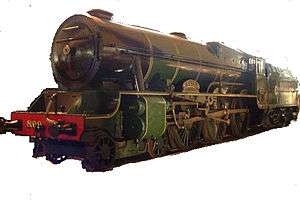GSR Class 800
|
GSR No. 800 Maeḋḃ | |||||||||||||||||||||||||||||||||||||||||||||||
| |||||||||||||||||||||||||||||||||||||||||||||||
| |||||||||||||||||||||||||||||||||||||||||||||||
| |||||||||||||||||||||||||||||||||||||||||||||||
| |||||||||||||||||||||||||||||||||||||||||||||||
%2C_Cultra_-_geograph.org.uk_-_2760665.jpg)
The Great Southern Railways Class 800 steam locomotives were built principally for express passenger work on the Dublin to Cork main line of that company. These locomotives were designed under the supervision of E. C. Bredin with his Chief Draughtsman, H. J. A. Beaumont, preparing the drawings. They were the largest and most powerful engines ever to run in Ireland by quite a large margin.
Design
The engines had three 18.5 by 28 inches (470 mm × 711 mm) cylinders and 225 pounds per square inch (1.55 MPa) boiler pressure. The nominal tractive effort was 34,799 lbf (154.8 kN), which corresponded with Great British main-line power. Further, it was the only design which exploited the full extent of the extra width afforded by the 5 ft 3 in (1.60 m) gauge. Originally four or five were to be built, named Maeḋḃ,[1] Maċa, Tailté, Gráinne, and Deirdre, but only three were eventually turned out - 800 Maeḋḃ in 1939, with Maċa (801) and Tailté (802) in 1940, along with a fourth boiler which acted as a spare. They were intended for the Dublin–Cork route but wartime coal shortages and the early 1950s advent of diesels on main line services resulted in their never having had much chance to show what they were capable of. In the 1950s they gradually became neglected and even resorted to light goods trains on occasion, with little other work to do.
| No. | Built | Irish Name | Anglicised name | Withdrawn | Notes |
|---|---|---|---|---|---|
| 800 | 1939 | Maeḋḃ | Maeve or Maedhbh | 1962 | Preserved |
| 801 | 1940 | Maċa | Macha | 1962 | scrapped |
| 802 | 1940 | Tailté | Tailtiu | 1955 | scrapped |
The name and number plates were of cast bronze with polished raised lettering and beading on a blue painted background. The nameplates’ lettering was in Gaelic script using dot above in place of the 'h' (see Irish orthography), although at first locomotive 800 carried an Anglicised name Maeve in roman type.
No. 800 Maeḋḃ was withdrawn from service in 1962 and is now on display at the Ulster Folk and Transport Museum, Cultra, Northern Ireland.
Livery
The locos were turned out in a unique livery, which no other locomotives ever carried. In the height of the Great Southern era, when every single locomotive in Ireland wore a plain unlined battleship grey livery, these engines were turned out in a smart mid green, with a distinct bluish tint. The green was lined in black and light yellow, and the GSR coat of arms was carried on the tender, flanked by large pale yellow letters "G S", which appear to have been shaded in red and gold. The cabside number plates and nameplates had blue backgrounds, and raised polished brass rims and numerals.
In Córas Iompair Éireann days they received the 1950s standard green, somewhat darker than they had carried before, with black and white lining . In the early 1950s Tailté was apparently repainted a light green, as an experiment. The colour was not unlike the green used for coaches on CIE in the late '50s, but she was then repainted like her sisters. Maċa and Tailté's nameplates and cab side number plates were given red backgrounds in the mid '50s as apposed to the dark blue that they had originally, however Maeḋḃ retained the blue background. This is the livery the preserved 800 carries, though rather than the CIÉ "Flying snail" emblem which would be appropriate to this later livery, it incorrectly carries the earlier "G S" without shading, and a replaced GSR coat of arms.
Service
The locos entered service between 1939 and 1940. Their axle load was 21 tons which meant that they could only work on the Dublin-Cork mainline. They were noted for climbing the steeply graded route from Cork Kent station (then Glanmire road station) unassisted, but because of coal shortages after WWII they never got a chance to show their full potential. They were slightly modified in the early '50s with Maċa and Tailté receiving single funnels and all three gaining extra hand-railings and a wheel on the smoke-box door instead of a dart. The main difference following these modifications was a decrease in tractive effort. In the mid-'50s with the arrival of the Vickers A class diesel locomotives they were made virtually redundant with Tailté being taken out of service in 1955 and scrapped two years later. However Maeḋḃ and Maċa remained in service pulling light expresses and goods trains. Maeḋḃ was taken out of service in 1962 and was repainted at Inchicore for preservation. Both nos. 800 and 801 were noted for being at Thurles in the '60s after withdrawal. Maċa was retubed for an IRRS tour in 1964 and was steamed up for the last time. After this she was scrapped. Having been at Thurles for a year 800 was brought to the Belfast Museum. In 1993 Maeḋḃ, along with the NCC compound Dunluce Castle and the GNR S class 4-4-0 no. 171 Slieve Gullion were brought to the new Ulster Folk and Transport Museum, Cultra.
Models
An etched brass 4mm scale model is available from Studio Scale Models.
See also
- Coaching Stock of Ireland
- Diesel Locomotives of Ireland
- Multiple Units of Ireland
- Steam locomotives of Ireland
References
- Clements, Jeremy & McMahon, Michael (2008). Locomotives of the GSR. Newtownards: Colourpoint Books. pp. 271–277. ISBN 978-1-906578-26-8.
| ||||||||||||||||||||||||||||||||||||||||||||||||||
